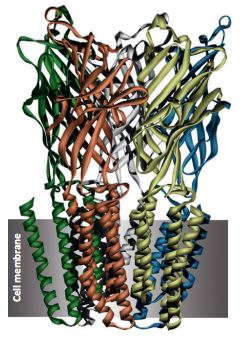Introduction of 5-HTR3C
5-hydroxytryptamine receptor 3C (5-HTR3C), also called the serotonin receptor 3C, is subunit C of the type 3 receptor for 5-hydroxytryptamine (serotonin), which is identified as a biogenic hormone that functions as a neurotransmitter, a mitogen and a hormone. This receptor in humans is encoded by the HTR3C gene. Notably, the HTR3C gene is absent from the rodent genome. In human, it is found in many tissues including adult brain, intestine, colon, lung, stomach and muscle, as well as fetal colon and kidney.
| Basic Information of 5-HTR3C | |
| Protein Name | 5-hydroxytryptamine receptor 3C |
| Gene Name | HTR3C |
| Aliases | Serotonin receptor 3C, 5-HT3-C, 5-HT3C |
| Organism | Homo sapiens (Human) |
| UniProt ID | Q8WXA8 |
| Transmembrane Times | 4 |
| Length (aa) | 447 |
| Sequence | MEGGWPARQSALLCLTVSLLLQGRGDAFTINCSGFDQHGVDPAVFQAVFDRKAFRPFTNYSIPTRVNISFTLSAILGVDAQLQLLTSFLWMDLVWDNPFINWNPKECVGINKLTVLAENLWLPDIFIVESMDVDQTPSGLTAYISSEGRIKYDKPMRVTSICNLDIFYFPFDQQNCTFTFSSFLYTVDSMLLGMDKEVWEITDTSRKVIQTQGEWELLGINKATPKMSMGNNLYDQIMFYVAIRRRPSLYIINLLVPSSFLVAIDALSFYLPAESENRAPFKITLLLGYNVFLLMMNDLLPASGTPLISVYFALCLSLMVVSLLETVFITYLLHVATTQPPPMPRWLHSLLLHCTSPGRCCPTAPQKGNKGLGLTLTHLPGPKEPGELAGKKLGPRETEPDGGSGWTKTQLMELWVQFSHAMDTLLFRLYLLFMASSILTVIVLWNT |
Function of 5-HTR3C Membrane Protein
The 5-HTR3 receptor is known as the only ligand-gated ion channel (LGIC) within the family of 5-HTR receptors. The 5-HTR3C receptor is a ligand-gated ion channel, which causes fast, depolarizing responses upon activation. It consists of a huge N-terminal extracellular segment that contains a cysteine loop, four hydrophobic transmembrane regions, a large intracellular loop between the third and fourth transmembrane region, and an extracellular C terminus. The 5-HTR3C receptor is a cation-specific, but otherwise relatively nonselective, ion channel. The 5-HTR3C subunit in human does not act as a homomer. One study has shown that 5-HTR3C subunit alone is incapable of forming functional receptors. However, coexpression with 5-HTR3A leads to the formation of functional heteromeric complexes with different serotonin efficacies. The potency of agonists and antagonists observed for homopentameric 5-HTR3A receptors will not be altered by the co-expression of the 5-HTR3C and 5-HTR3A subunits.
 Fig.1 Ligand binding sites in the 5-hydroxytryptamine3 receptor. (Thompson, 2013)
Fig.1 Ligand binding sites in the 5-hydroxytryptamine3 receptor. (Thompson, 2013)
Application of 5-HTR3C Membrane Protein in Literature
The findings of this study indicate that serotonin 5-HT3C receptor gene is associated with the frequency of CINV.
Authors in this article provide a strong basis for future studies of the roles that specific 5-HT3 receptor subtypes play functions in the enteric and central nervous systems.
Authors in this study suggest that RIC-3 (a chaperone) can interact with 5-HT3A, -C, -D, and -E subunits.
The results show that the expression or function of 5-HT(3A) receptor is modified by 5-HT(3C) and 5-HT(3E).
5-HTR3C Preparation Options
To prepare the soluble and functional target protein, our experienced scientists present robust reconstitution forms as well as multiple active formats for membrane proteins, with fast turnaround times. Our Magic™ membrane protein production platform allows robust reconstitution forms as well as multiple active formats for membrane proteins. Aided by our versatile Magic™ anti-membrane protein antibody discovery platform, we also provide customized anti-5-HTR3C antibody development services.
Creative Biolabs provides high-quality PK assay procedures and applies its expertise in a range of membrane protein preparation services. Our scientists have longstanding experience in membrane protein preparation by combining the most advanced technology around the world. Please feel free to contact us for more information.
Reference
All listed services and products are For Research Use Only. Do Not use in any diagnostic or therapeutic applications.